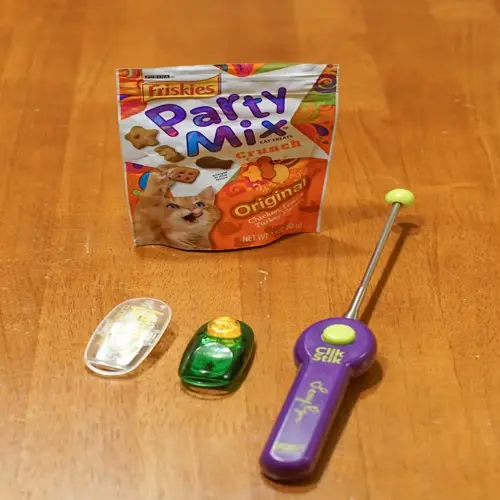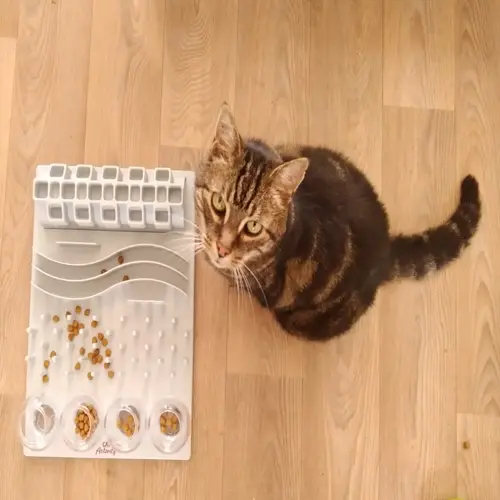Complete Cat Feeding Guidelines for Every Owner

Written by
John Williams
Reviewed by
Prof. Henry Webster, Ph.D.Adhere to specific cat feeding guidelines that appropriate for their life stage and weight
Introduce new foods slowly over a 7-day period to minimize digestive upset in cats
Treats should be limited to ≤10% of the daily calorie intake, using healthy options like chicken
Use monthly body condition scoring to monitor weight changes and adjust portion sizes as appropriate
Consult with a veterinarian for nutritional adjustments during changes in health or aging
Use hunting simulation methods like puzzle feeders for mental stimulation during meals
Article Navigation
Understanding the cat feeding guidelines begins with an awareness that cats are obligate carnivores and need animal protein to thrive. I learned early on in my veterinary career that cats develop health problems on plant-based diets. Meat provides vitamins and minerals that cats cannot manufacture themselves.
The statistics report that 61% of cats are overweight, which I see daily at my clinic, is quite alarming. This epidemic is caused by improper portion control and the practice of free feeding. If you consider your cat's weight, age, and activity level, you can avoid this. Every cat requires an individualized approach.
Never create feeding plans without veterinary consultation. I always recommend that owners have their cats evaluated by a professional. Your veterinarian should assess body condition scores and determine a nutrition plan. This will provide an individualized opportunity to address specific health needs and minimize the most common mistakes associated with feeding.
Wet vs Dry Food Comparison
There's a huge difference in moisture content between wet and dry food. Wet food has a moisture content of 75-85%, which is similar to the water content in the prey of cats. Dry food has a moisture content of only 6-10%, which worries me, as a vet, because cats have a naturally low thirst drive. That is why wet food is excellent for hydration, and denser, moistened food is amazing for kidney health.
The calorie density also varies significantly. The dry food provides more calories per gram, which can lead to unintentional overfeeding. I frequently see overweight cats that are being fed dry diets. The wet food offers a greater volume for fewer calories. Properly portioned according to your cat's needs, this helps maintain healthy body weight.
Many cat owners think that cat dry food cleans their pet's teeth, but the dental benefits are negligible. Cats do not chew dry food properly for real cleaning. In my practice, I find equal dental problems with all feeding methods. The real dental treatment involves brushing the teeth or having a veterinary cleaning; dry food alone is not enough.
Prices matter when it comes to pet food for many owners. Dry food may appear cheaper per bag; however, wet food offers a better nutritional value. Don't forget potential veterinary bills associated with obesity or dehydration. A balance of the two forms of food is advisable in many instances. Use wet food for meals and measured amounts of dry food in between meals for cost and health.
Hydration Benefits
- Wet food provides 70-85% of daily water needs (4-5 oz/113-142g per 5.5 oz can)
- Essential for cats with kidney concerns or low water intake
- Dry food requires constant fresh water access to prevent dehydration
Storage Solutions
- Refrigerate opened wet food at 40°F/4°C for maximum 3 days
- Use airtight containers for dry food to prevent rancidity
- Store in cool, dark locations below 77°F/25°C
Cost Analysis
- Dry food offers 30% cost savings per calorie (e.g., $0.10 per 100 kcal)
- Wet food may reduce long-term vet costs for urinary health
- Combination feeding balances budget and health needs
Dental Health Facts
- Myth: Dry food cleans teeth - requires veterinary dental diets
- Wet food leaves no residue but doesn't prevent tartar
- Annual dental cleanings recommended regardless of diet
Transition Guidance
- Gradual 7-day shift when changing food types
- Serve wet food at room temperature (68°F/20°C) for best aroma
- Always provide separate bowls for each food type
Portion Sizes & Feeding Frequency
The precise measurement of portion sizes must take your cat's weight into account: A 5-pound cat (2.3kg) needs 160g wet food (5.6oz) or 35g dry food (1/3 cup) weight of food. Use kitchen scales for precision. Many owners who do not measure out portion sizes will usually end up overfeeding their cats. I always weigh my cats' meals to make sure This food measurement is accurate.
Meal frequency varies significantly across different life stages. Kittens (4 or more feedings daily) require frequent feedings for optimal growth, while adults (2-3 meals daily) do best on this schedule. Seniors tend to perform better with smaller and more frequent feedings. I modify schedules according to each cat's metabolism and energy needs. Never leave food accessible throughout the day.
Constant grazing, caused by free-feeding, increases obesity risks. Cats will graze and do not have natural roadblocks, hence, there is an unlimited risk of gaining weight. From my practice, I see cats that gain 20% excess free-feed weight, which can be avoided by providing measured meals, thereby promoting compliance, as each eater receives the exact number of calories.
Employ hunting simulation techniques to simulate natural behavior. Use puzzle feeders, which release kibble during play, or hide food in foraging mats. My cats have food puzzles to solve daily, which promotes mental stimulation and slows down their eating. This technique not only prevents gulping but also facilitates digestion.
Kittens (Under 1 Year)
- Require 4+ meals daily for growth and energy
- High-protein food (30%+) for muscle development
- Calorie intake: 2-3 times adult requirements
Adults (1-7 Years)
- Optimal schedule: 2-3 measured meals
- Prevent obesity by avoiding constant food access
- Adjust portions monthly based on weight checks
Seniors (7+ Years)
- 3-4 smaller meals with digestible proteins
- Address reduced mobility with accessible bowls
- Monitor kidney health with increased hydration
Active/Outdoor Cats
- Increase calories by 15-20% for high activity
- Provide weather-protected feeding stations
- Supplement with high-fat treats for energy
Weight Management
- Target 1-2% weekly weight loss for obesity
- Use timed feeders to control intake
- Replace 10% food with low-calorie veggies (vet-approved)
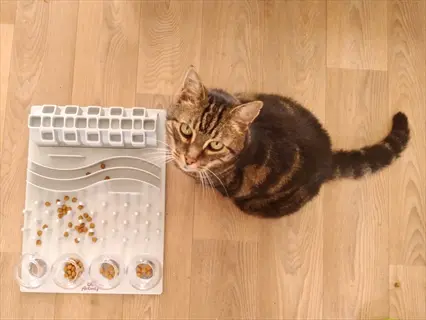
Puzzle Feeders
- Mental stimulation: Puzzles slow eating by 50% while providing essential cognitive enrichment through problem-solving activities
- Portion control: Ideal for distributing dry food throughout the day without overfeeding risks by requiring physical effort for access
- Behavioral benefits: Reduces boredom-related overeating by transforming feeding into engaging problem-solving challenges
- Implementation guide: Start with beginner-level maze designs before progressing to advanced multi-step puzzle configurations
- Maintenance protocol: Clean all components weekly with pet-safe disinfectants to prevent bacterial growth in food crevices
- Long-term strategy: Rotate different puzzle types monthly to maintain challenge levels and prevent habituation to specific designs
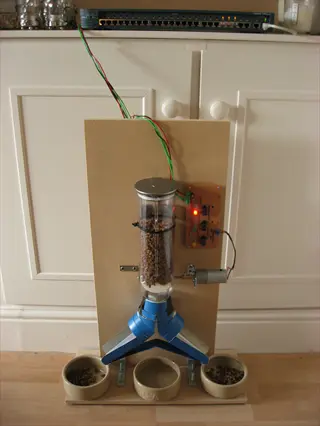
Timed Dispensers
- Natural patterns: Program 4-6 small meals to mimic feline hunting rhythms and support optimal digestion cycles
- Consistency advantage: Maintains reliable feeding schedules during work absences or travel disruptions to reduce anxiety
- Multi-cat solution: Prevents food guarding by dispensing exact portions simultaneously in separate household locations
- Freshness preservation: Use ice packs with wet food models to maintain safe temperatures below 40°F/4°C
- Activity promotion: Position units away from resting areas to encourage movement between feeding stations
- Reliability check: Test battery backup systems monthly to ensure operation during unexpected power outages
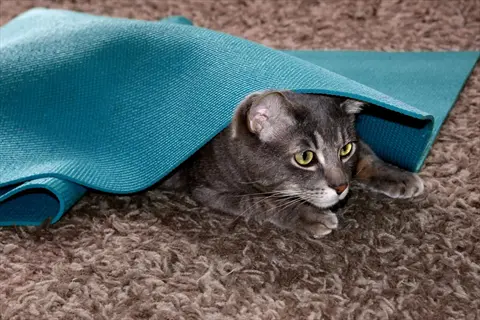
Scatter Feeding
- Natural foraging: Spread kibble across surfaces to stimulate instinctual hunting and tracking behaviors
- Hunting simulation: Mimics prey pursuit sequences requiring visual scanning and paw coordination skills
- Physical activity: Encourages stretching and light movement through deliberate food-searching actions
- Practical setup: Use textured silicone mats with suction bases to prevent sliding during enthusiastic foraging
- Food safety: Limit to dry kibble only to avoid spoilage and messy cleanup complications
- Training protocol: Supervise initial sessions to demonstrate technique using scent trails and visible placements
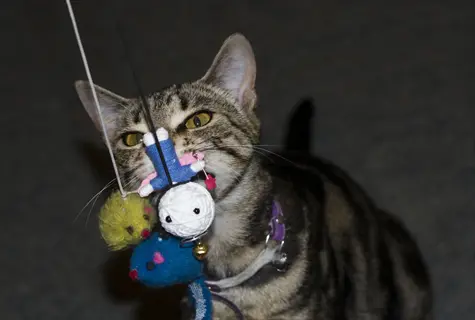
Toy Integration
- Active feeding: Attach food compartments to chase toys that release kibble during successful hunting maneuvers
- Behavior reinforcement: Reward pouncing and capturing actions with immediate food rewards to strengthen instincts
- Positive association: Build connections between vigorous play and nutritional satisfaction through timed releases
- Calorie management: Strictly limit rewards to 10% of daily intake to maintain balanced nutritional profiles
- Design specifications: Select lightweight attachments that preserve natural toy movement dynamics during play
- Safety requirement: Always monitor sessions to prevent accidental ingestion of non-food components during excitement
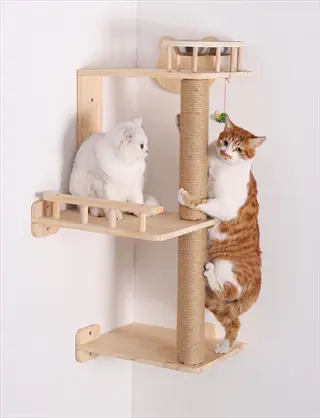
Elevated Stations
- Natural positioning: Place bowls on vertical surfaces to encourage species-typical perching while eating
- Territorial benefit: Provides vantage points for environmental monitoring during meal consumption
- Accessibility feature: Reduces joint strain for senior cats by eliminating uncomfortable ground-level bending
- Stability standards: Ensure platforms have non-slip surfaces and robust construction to prevent accidents
- Enrichment value: Position near windows to combine feeding with bird-watching and outdoor stimulation
- Hygiene protocol: Clean surrounding surfaces weekly to prevent dust accumulation near food contact areas
Life Stage Nutrition Guide
Different life stages have protein and fat needs. Kittens need ≥30% protein for muscle growth and 18-22% fat for energy. Adult cats need 26-30% protein for the maintenance of life with less fat. Average cat needs ≥30% protein for muscle wasting and less fat for easier digestion.
Special nutrients are necessary for kittens and old cats. Kittens get DHA for brain development and extra calcium for growing bones. Old cats need less phosphorus to protect their kidneys and glucosamine to maintain joint health. I give my old cat an omega-3 supplement to help with her arthritis.
Pregnancy and lactation necessitate significant adjustments to a cat's nutritional intake. *Lactating cats require triple their calorie needs and 1.5% calcium in the diet for the sake of milk production.* Cats will frequently consume kitten-formulated foods during this time period. I have helped many foster parents successfully switch nursing mothers to high-calorie diets safely.
Transitioning between life stages is important and involves some careful procedures. Diets should be transferred gradually over 7 to 10 days, combining old food with new food. Look for changes in appetite or digestive disturbances. Always consult your veterinarian before changing the formula for senior cats or any cat with health conditions.
Kitten Development (0-12 Months)
- Milk to solids: Transition over 4 weeks starting at 3-4 weeks old
- Frequency: 4+ meals daily of high-calorie food (400+ kcal/cup)
- Key supplements: DHA for brain development, probiotics for digestion
- Weaning: Complete by 8 weeks with texture progression (gruel → chunks)
Adult Maintenance (1-7 Years)
- Metabolic shift: Reduce calories by 15% post-neutering
- Dental care: Incorporate dental treats if vet-approved
- Weight monitoring: Monthly checks to prevent obesity onset
- Activity pairing: Schedule meals after play sessions
Senior Health (7+ Years)
- Digestibility focus: Hydrolyzed proteins, reduced phosphorus
- Joint support: Glucosamine/chondroitin fortified foods
- Hydration: Add water to wet food (1:4 ratio)
- Bloodwork: Bi-annual vet checks to adjust nutrients
Pregnancy & Nursing
- Calorie surge: Up to 3x normal intake during lactation
- Calcium boost: 1.5% content to support milk production
- Feeding style: Unlimited access to kitten-formulated food
- Weaning support: Gradual reduction over 4 weeks post-weaning
Transitioning Between Stages
- Timing: Shift diets over 7-10 days to prevent digestive upset
- Monitoring: Watch for appetite changes or stool abnormalities
- Vet consultation: Required for medical conditions (kidney/diabetes)
- Appetite stimulants: Use vet-prescribed options if refusal >24hrs
Food Transition & Treat Management
Utilize a strict 7-day transitional feeding program to avoid gastrointestinal upset. Use 75% old food and 25% new food days 1 and 2. Begin at 50% old food and 50% new food on days 3 and 4. Then use 25% old food and 75% new food days 5 and 6. Finish this transition before using 100% of the latest diet.
Treats need to stay ≤10% of daily calories. If a 10-pound cat requires 200 calories, that would be a maximum of 20 calories per pound. I use kitchen scales to measure out treats. This avoids overfeeding. Increase main meals if you give extra treats, to maintain balance.
Select nutritious treat substitutes with added health benefits. Provide cooked chicken (35 kcal/oz) for lean protein. Use freeze-dried salmon (15 kcal/ piece) for its omega-3 content. Use pumpkin puree (10 kcal/tsp) to help digestion. These are all nutritious foods that add nutrients rather than empty calories.
For food refusal, warm canned food to 100 degrees Fahrenheit (38 degrees Celsius) or add nutritional yeast. If refusal continues for more than 24 hours, contact your veterinarian immediately if there is vomiting, sudden weight changes, or any signs of nutritional deficiency.
Calorie Limits
- 10% Rule: Maximum 20 kcal treats daily for 10lb cat (200 kcal total)
- Adjust main meals to compensate for treat calories
- Measure treats with kitchen scales for accuracy
Healthy Alternatives
- Cooked chicken: 35 kcal/oz (123 kcal/100g) - lean protein source
- Freeze-dried salmon: 15 kcal/piece - omega-3 rich
- Pumpkin puree: 10 kcal/tsp (2 kcal/ml) - fiber for digestion
Behavioral Rewards
- Puzzle feeders: Dispense 1-2 kibbles per successful interaction
- Play sessions: Replace food rewards with 5-minute play intervals
- Grooming time: Brush as reward instead of treats
Food Refusal Solutions
- Temperature adjustment: Warm wet food to 100°F/38°C
- Topping tricks: Add 1/4 tsp (1.25g) nutritional yeast or fish oil
- Scheduled fasting: Withhold food 12 hours then reintroduce
Vet Consultation Triggers
- Appetite loss: >24 hours without eating
- Vomiting: More than 2 episodes during transition
- Weight changes: >5% loss/gain in 1 week
Body Condition & Monitoring
Check your cat's ideal weight indicators using simple visual and tactile methods. There should be a visible waist behind the ribs as viewed from above, and from the side, a hindquarters tuck which, upward. Feel the ribs with light pressure; the ribs should feel like the back of your hand, neither protruding nor buried in fat.
Use an accurate tool like baby scales to monitor your weight tracking protocol with a precision of 0.1oz/2g accuracy. Weigh yourself every month at the same time of day, for example, just before meals. Record the results in a logbook for evaluation of any trends that may emerge. I record my cats' weights every first Sunday morning.
Gradually adjust amounts for weight fix. Weekly increase calories by 10-15% in underweight cats. Weight decrease calories by 5% every two weeks for overweight cats. The senior feeding program should focus on increasing protein intake while reducing calories. Food should be weighed using scales instead of cups globally.
Veterinary advice should be sought if any of the following occur. Sudden weight loss of more than 5% within a month suggests there may be an underlying condition. An increased consumption of water would indicate the possibility of kidney problems. A dull coat with skin problems would indicate nutritional deficiencies. If any animal shows refusal to eat for greater than 24 hours, immediate action should be taken.
Ideal Weight Indicators
- Rib check: Should feel like back of hand with light pressure
- Waist view: Visible indentation behind ribs from above
- Profile check: Abdomen tucks upward toward hind legs
Weight Tracking
- Tools: Baby scales (accurate to 0.1 oz/2g) or pet scales
- Frequency: Weigh monthly at same time of day
- Record keeping: Track trends over 3-month periods
Portion Adjustments
- Underweight cats: Increase by 10-15% calories weekly
- Overweight cats: Reduce by 5% calories biweekly
- Senior adjustments: Prioritize protein preservation
Health Warning Signs
- Sudden weight loss: >5% in one month requires vet visit
- Increased thirst: Possible kidney or diabetes concern
- Coat deterioration: Sign of nutritional deficiencies
Veterinary Partnership
- Annual checks: Professional body condition assessment
- Bloodwork: Baseline tests at ages 7, 10, and 13 years
- Prescription diets: Required for medical conditions
5 Common Myths
Cats instinctively regulate their food intake and will not overeat if food is placed before them nonstop.
Therefore, free-feeding practices have caused a great number of domestic cats to become overweight because of instincts which have evolved which cause them to eat food when it is available. With food and predominant exercise results in food of considerable calorie density, the natural regulatory mechanisms of energy intake do not work, forcing owners to portion food supplies by physical feeding instead of depending upon self-regulation to prevent obesity and conditions of related health dysregulation.
Milk from cows is a nutritious and healthy treat that offers needed hydration and nutrition for adult cats.
Many adult cats become lactose intolerant after weaning and suffer digestive problems (diarrhea and vomiting) from dairy consumption. Kittens produce enzymes to digest milk, whereas adults lose this ability with the absence of maternal milk from their diets. Therefore, specially produced cat milk or fresh water is the only safe source of hydration available that does not cause gastrointestinal distress or nutritional imbalance.
The dry food does clean cats' teeth well by the mechanical action of chewing out tartar, which keeps down odontalgia.
The dry food gives no reduction in tartar build-up since cats swallow their food and kibble whole, instead of chewing sufficiently. Periodontal trouble can be avoided or alleviated by feeding certain textured foods and regularly cleaning the teeth as tartar ranks irrespective of food used and therefore professional treatment is necessary.
Grain-free diets are vastly superior to all diets for all cats. They also prevent common food allergies much better than any diets available.
Some food formulations may impair heart health due to problems with food absorption of nutrient from certain ingredients. True food allergies are very rare in cats, and relate to animal proteins rather than grains, making careful elimination trials under veterinary supervision programs must used before drastic dietary modifications are tried to insure adequate nutrition.
The biological makeup of cats is perfect for raw meat diets, and freezing meat products eliminates contamination possibilities.
@ Raw food preparations may be made from raw products that contain organisms that will survive the freezing process and thus potentially cause health hazards to cats as well as humans. Cooked food preparation will preserve essential food values and eliminate the organisms that will cause disease, and properly formulated cooked diets offered by the veterinarian will offer complete and balanced nutrition to the cat in a safe manner without the hazard or problems of contamination with uncooked meat products.
Conclusion
Establishing individualized feeding regimes is still important to keep your cat healthy throughout life. The portions should be based on weight, age, and activity level, as living conditions may alter the quantity. I have known cats who would benefit from their owners preparing their food to suit the individual cat's particular requirements, rather than relying on the standard feeding guide. It is that individuality which counts.
Ensure long-term health by monitoring critically. Weigh animals each month on scales that measure accurately. Visually and palpably monitor body condition scores. Write down what you find in a journal. Observing symptoms often helps diagnose illnesses before they become serious problems.
Involve your veterinarian with nutritional changes for lifestyle changes. Schedule annual check-ups and blood tests at key ages. Seek immediate advice for weight changes or appetite changes. My veterinarian's advice helped me adjust my senior cat's diet to support kidney health.
Your decisions regarding your cat directly influence their well-being. Good nutrition prevents illness and contributes to quality years. Start following these recommendations today and notice the remarkable improvement in your cat's health and energy!
External Sources
Frequently Asked Questions
How much should I feed my cat daily?
Daily portions depend on weight, age, and activity level. Use precise measurements with kitchen scales and follow veterinary guidelines. Adjust based on monthly body condition scoring to maintain ideal weight and prevent obesity.
Is free-feeding acceptable for cats?
Free-feeding often leads to overeating and obesity. Instead, provide measured meals at scheduled times. Use timed dispensers or puzzle feeders to regulate intake and mimic natural hunting behaviors for better weight management.
How do I transition my cat to new food?
Implement a gradual 7-day transition protocol:
- Days 1-2: 75% old food, 25% new food
- Days 3-4: Equal mix of both foods
- Days 5-6: 25% old food, 75% new food
- Day 7: Fully switch to new food
What are healthy treat alternatives for cats?
Opt for low-calorie, nutritious options that provide benefits without excess calories. These should complement regular meals while supporting hydration or dental health when used responsibly.
- Cooked chicken (lean protein source)
- Pumpkin puree (digestive fiber support)
- Freeze-dried salmon (omega-3 fatty acids)
How often should I weigh my cat?
Conduct monthly weight checks using precise pet scales. Track trends over 3-month periods and consult your veterinarian immediately if you notice sudden changes exceeding 5% of body weight in either direction.
Should cats have constant access to water?
Fresh water must always be available, especially for cats eating dry food. Place multiple bowls throughout your home and consider water fountains to encourage hydration and support kidney health.
What indicates my cat is overweight?
Recognize these physical signs of excess weight:
- Inability to feel ribs with light pressure
- Absence of visible waist behind ribs
- Lack of abdominal tuck in profile view
- Noticeable fat pads near hindquarters
Can cats regulate their own food intake?
Most domestic cats lack reliable self-regulation due to evolutionary instincts that drive overeating. Active portion control through measured meals is essential to prevent obesity and related health complications.
How does age affect feeding requirements?
Nutritional needs change significantly through life stages:
- Kittens: Require frequent high-protein meals
- Adults: Need calorie-controlled maintenance diets
- Seniors: Benefit from easily digestible formulas
- Pregnant/nursing cats: Demand increased calories
When should I consult a vet about feeding?
Seek veterinary guidance immediately for these concerns:
- Appetite loss exceeding 24 hours
- Repeated vomiting during food transitions
- Unexplained weight fluctuations over 5%
- Signs of nutritional deficiencies
